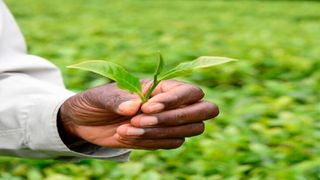
A leaf harvested from a team farm in Limuru, Kiambu county on May 13, 2021.
| Diana Ngila | Nation Media GroupSeeds of Gold
Premium
Increased rain and temperature to change taste of tea, new study says
What you need to know:
- Thousands of livelihoods are in jeopardy as the experts say production is likely to dip in the next 29 years.
- New report indicates that climate change is leading to erratic rainfall, floods and droughts, with rising temperatures posing a threat to crops.
Your favourite cup of tea could taste different in the coming years, thanks to climate change.
A report by British charity Christian Aid indicates increased rainfall and temperature could alter the taste, aroma and potential health benefits of the beverage.
Global warming could also affect the lives of tea farmers.
The report “Reading the Tea Leaves, Climate Change and Global Tea” examines the impact of climate change on the world’s biggest tea-growing nations of China, India, Sri Lanka and Kenya.
And thousands of livelihoods are in jeopardy as the experts say production is likely to dip in the next 29 years if measures are not taken to reverse the effects.
The study shows global warming has brought unseasonably high levels of rainfall in different parts of the world, meaning tea plants are being pushed beyond their precipitation limits.
This means farmers risk losing their livelihood if a temperature rise of a few degrees occurs as large areas would be rendered unsuitable for the crop.
Climate change
“Tea plants can only take a certain threshold of water, meaning they can grow to size because of the extra rain but the leaves will be of inferior quality, leaving the tea tasteless,” the study says.
According to the report, climate change is leading to erratic rainfall, floods and droughts, with rising temperatures posing a threat to crops.
“By 2050, climate change is going to slash optimal conditions for tea production by a quarter, as areas growing it around Mt Elgon and Mt Kenya will totally be absent under all projections,” it says.
The report notes that half of the tea consumed in the United Kingdom is grown in Kenya, where tea is a key plank of the economy, while 85 per cent of Kenya’s tea is sold in the UK.
The researchers report a bleaker outlook for areas that have average tea-growing conditions.
“It will be very hard for tea growers to move to new previously uncultivated regions. Tea is unlikely to be established in the areas of Kenya where it had not existed,” the researchers say.
Kenya has had the perfect climate for growing tea, thanks to its tropical, red volcanic soils and long sunny days.
A tea plantation does best in mountainous regions with temperatures ranging between 16 and 29 degrees centigrade, accompanied with a stable rainfall.
Tea-growing regions
But climate change threatens all that, with projections indicating that by 2050, tea production in these areas will fall by 39 per cent.
In a survey of 700 farmers in the seven tea-growing regions of Kenya, the UN’s Food and Agriculture Organisation found farmers observed that changes in rainfall patterns, distribution and reduced tea yields were tied to climate change.
At least 43 per cent of respondents said they had noticed a change in rainy seasons that led to a shift in planting seasons while 35 per cent cited drought.
Between October and mid-November 2019, the country recorded rainfall up to 400 per cent higher than average.
These conditions, experts say, were conducive for locusts, which invaded these parts and consumed vegetation.
The experts say when tea plants get really wet, they lose the ecological cues necessary for the release of chemicals that enhance flavour and give it antioxidant properties.
Projections indicate temperatures in Kenya will rise by 2.5 degrees centigrade between 2000 and 2050 and rainfall will become more intense.





